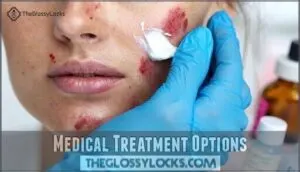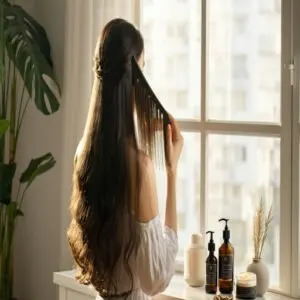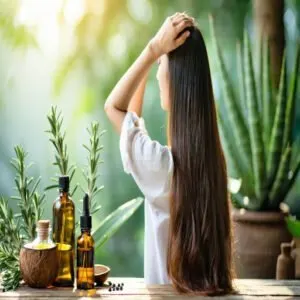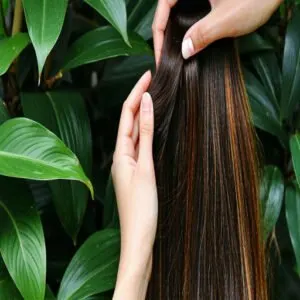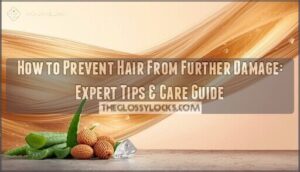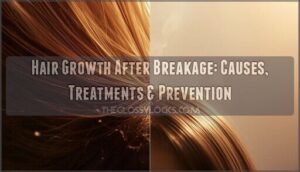This site is supported by our readers. We may earn a commission, at no cost to you, if you purchase through links.

A Mediterranean diet—think leafy greens, nuts, and olive oil—can work wonders for scalp health.
Get enough protein, iron, and vitamins to support follicles, and don’t forget hydration!
Minoxidil (Rogaine) is a proven option for regrowth, while gentle scalp massages boost blood flow.
Be gentle: skip tight hairstyles, heat tools, and harsh chemicals.
Stress can sneakily contribute to thinning, so mindfulness or yoga might save more than your sanity.
Worried about medical causes? Check for thyroid imbalances or nutrient deficiencies.
Curious about how lifestyle tweaks help even more?
Table Of Contents
- Key Takeaways
- Female Hair Loss Causes
- Dietary Approaches
- Medical Treatment Options
- Hair Care Prevention Tips
- Prevention Strategies
- Frequently Asked Questions (FAQs)
- How do I stop my hair from falling out as a female?
- Does anything really work for female hair loss?
- What vitamin am I lacking if my hair is falling out?
- What is the number one cause of female hair loss?
- Can pregnancy increase hair shedding temporarily?
- How does menopause affect scalp hair thickness?
- Are certain hairstyles linked to hair thinning?
- Does sleeping position influence hair fall amount?
- Can seasonal changes impact hair growth cycles?
- Conclusion
Key Takeaways
- Prioritize a Mediterranean diet with leafy greens, nuts, and olive oil to nourish your scalp and support healthy hair.
- Use gentle hair care practices like sulfate-free shampoos, avoiding tight hairstyles, and limiting heat styling to prevent damage and thinning.
- Address potential causes like hormonal imbalances, thyroid issues, or nutrient deficiencies by consulting a doctor and maintaining a balanced diet with essential vitamins and minerals.
- Manage stress with techniques like mindfulness, yoga, or scalp massages to reduce shedding and promote healthy hair growth.
Female Hair Loss Causes
Hair loss in women can stem from a variety of causes like hormonal imbalances, thyroid issues, or even genetics.
Understanding these factors helps you address the problem early and keep your hair healthy.
Hormonal Imbalance
Hormonal imbalance is a major trigger for hair loss.
Shifts in estrogen levels, thyroid function, or adrenal health can disrupt growth cycles, leading to thinning or female pattern baldness.
To combat hormonal hair loss, try:
- Consult a doctor for hormone regulation.
- Manage stress to protect adrenal health.
- Track menstrual cycles for irregularities.
- Support thyroid health through balanced nutrition.
Understanding the effects of hormonal hair loss is essential for effective prevention and treatment.
Genetic Predisposition
If your mom or grandma struggled with female pattern baldness, you might face it too.
Hereditary factors, like androgenetic alopecia, influence FPHL through specific inheritance patterns.
Genetic testing or DNA analysis can confirm risks tied to family history.
Understanding these hereditary links helps you act early—think treatments like minoxidil or lifestyle tweaks to slow the process, considering your family history.
Thyroid Disorders
Thyroid disorders can sneak up on you, causing unexpected hair thinning.
Thyroid function impacts hormone regulation, which affects hair growth cycles.
Hypothyroidism symptoms like fatigue or weight gain often pair with hair loss.
Thyroid tests can uncover imbalances, while managing autoimmune triggers helps.
For hair loss prevention, women should address thyroid issues early to regain control and keep their locks healthy.
Autoimmune Disease
Sometimes, your immune system gets a little overzealous, mistaking your hair follicles for enemies.
Autoimmune diseases like alopecia areata can trigger an inflammation response, leading to patchy hair loss.
These hair loss causes in women often feel frustrating, but disease management is key.
Identifying autoimmune triggers and working with a specialist can help with hair loss prevention for women.
Nutritional Deficiencies
Your hair’s health depends on the right balance of nutrients.
Vitamin defects, like a lack of biotin or vitamin D, and mineral shortages, such as iron absence or zinc insufficiency, can trigger shedding.
A diet for hair loss should include leafy greens, lean meats, and nuts.
Several key vitamins, as discussed in this article about vitamin deficiency, contribute to keratin synthesis, follicle health, and overall hair strength.
Supplements for hair loss, like multivitamins, can help, but consult your doctor first.
Dietary Approaches
What you eat plays a big role in keeping your hair healthy and strong.
A balanced diet rich in protein, vitamins, and minerals can help prevent hair loss and support regrowth.
Mediterranean Diet Benefits
Embracing the Mediterranean Diet can work wonders for hair growth and hair loss prevention in women.
Packed with healthy fats, omega benefits, and nutrient balance, it’s a diet for hair loss that’s easy to love.
Men also benefit from a hair growth diet plan.
Try these:
- Load up on fresh veggies and herbs for vitamins.
- Add olive oil for healthy fats.
- Snack on nuts for omega-rich benefits.
Protein Rich Foods
Don’t skimp on protein—it’s like fuel for your hair.
Foods like eggs, nuts, beans, and Greek yogurt are exceptional protein sources that support hair growth.
Healthy snacks like almonds or a boiled egg can boost your nutrient balance.
You can explore various protein-rich food products to supplement your diet.
If meal planning feels tricky, consider food supplements to guarantee you’re getting enough protein for hair loss prevention in women.
Vitamin a Importance
Vitamin A plays a vital role in hair growth and skin health, but balance is key.
Too much can backfire, leading to hair loss.
Aim to include these in your diet:
- Sweet potatoes: Packed with beta-carotene.
- Spinach: A nutrient powerhouse.
- Carrots: Easy snack, big benefits.
- Mangoes: Sweet and vitamin-rich.
Consider dietary supplements if needed.
For ideal hair health, understanding Vitamin A supplements is essential to prevent deficiencies.
Iron Rich Foods
Iron-rich foods like spinach, lentils, and lean meats are game-changers for female hair loss prevention.
Your body needs dietary iron to support hair follicles and prevent thinning.
If food sources aren’t enough, consider exploring iron supplement products, but don’t overdo it—too much iron isn’t your friend.
Pair these foods with vitamin C for better absorption and stronger, healthier hair.
Balanced Diet Maintenance
Iron-rich foods are just one piece of the puzzle.
To truly support hair loss prevention in women, focus on nutrient balance through healthy eating and meal planning.
Embrace food variety—think colorful veggies, lean protein for hair strength, and vitamins for hair loss like B and D.
Avoid skipping meals; consistent caloric intake fuels your body and your hair’s growth cycle.
Medical Treatment Options
Regarding medical treatments for hair loss, you have several proven options available.
From FDA-approved solutions like minoxidil to advanced therapies like platelet-rich plasma injections, these treatments can help slow hair loss and even encourage regrowth.
Minoxidil Effectiveness
Minoxidil is a go-to for hair loss treatment in women, offering solid results for scalp health and hair regrowth.
To maximize treatment outcomes, consider the following steps:
- Apply it to a dry scalp twice daily for consistent results.
- Stick with foam formulations to reduce residue and boost convenience.
- Start early—Minoxidil works best for mild hair loss stages.
Patience pays off with visible hair regrowth!
Finasteride Usage
If you’re exploring hair loss treatment for women, finasteride could be an option.
It works by blocking DHT, a hormone linked to hair thinning.
While effective for female hair regrowth, it’s prescription-only and requires careful dosage instructions.
Treatment duration often spans months for noticeable results.
Always consult your doctor to stop hair loss and guarantee safe use.
Platelet Rich Plasma Injections
PRP therapy, or platelet-rich plasma injections, taps into your body’s healing power to boost female hair regrowth.
This cell therapy uses plasma rich in growth factors to stimulate dormant follicles.
It’s a safe, minimally invasive hair loss treatment for women.
While results vary, PRP injections show promise for androgenetic alopecia and hair loss prevention in women seeking effective, non-surgical options.
Low Level Laser Therapy
Low-level laser therapy offers a non-invasive way to tackle female androgenic alopecia.
This light therapy uses red lasers to boost scalp stimulation and hair regeneration.
Benefits?
- Thicker, healthier strands
- Improved blood flow for better nutrient delivery
- Reactivation of dormant follicles
- No pain or downtime
It’s an FDA-approved hair loss treatment for women, perfect alongside other hair growth products.
Steroid Treatments
Ever wondered if steroids can help with hair regrowth?
Corticosteroid use, like injections or topical treatments, is a proven hair loss treatment for women, especially for autoimmune conditions like alopecia areata.
Steroid injections target inflammation, promoting growth, while effective, steroid side effects like thinning skin or irritation exist.
Explore treatment options with your doctor to tackle female androgenic alopecia or other concerns.
Hair Care Prevention Tips
Taking care of your hair properly can go a long way in preventing unnecessary hair loss.
Simple changes like using gentle shampoos, avoiding heat styling, and protecting your scalp can help keep your hair healthy and strong.
Gentle Shampoos
Using a sulfate-free, gentle formula shampoo is key for hair loss prevention in women.
Look for options with moisturizing properties and scalp-soothing ingredients, these promote hair preservation and reduce irritation.
- Avoid harsh chemicals in shampoos.
- Choose womens hair loss products with natural extracts.
- Focus on hydration for scalp health.
- Opt for mild cleansers to prevent breakage.
- Stick to hair loss solutions women trust.
Avoiding Heat Styling
Styling tools like flat irons and curling wands can cause heat damage, leading to hair breakage and thinning over time.
Skip daily heat styling to support hair loss prevention in women.
If you must use them, apply thermal protection sprays and stick to gentle techniques.
Your hair will thank you for the break!
| Problem | Cause | Solution | Benefit | Tip |
|---|---|---|---|---|
| Hair Breakage | Excessive Heat | Use Thermal Sprays | Reduced Damage | Apply evenly on hair |
| Hair Thinning | Daily Heat Styling | Limit Heat Usage | Healthier Strands | Style only occasionally |
| Split Ends | High Temperatures | Lower Heat Settings | Less Breakage | Use tools below 300°F |
| Dull Hair | Overuse of Tools | Air-Dry Occasionally | Natural Shine | Let hair rest weekly |
| Scalp Irritation | Prolonged Heat | Avoid Styling Tools | Improved Scalp Health | Use heat-free methods |
Protective Hair Habits
Skipping heat tools is smart, but how you handle your hair daily matters too.
Protect your strands with these habits:
- Gentle Combing: Use a wide-tooth comb to reduce breakage.
- Scalp Protection: Opt for loose hair ties to avoid pulling.
- Daily Trimming: Keep split ends at bay for healthier growth.
Simple tweaks can help prevent hair loss in women.
Natural Product Treatments
Regarding natural hair loss remedies, essential oils like rosemary extract can work wonders, showing results similar to minoxidil.
Coconut oil protects against damage, while aloe vera soothes and hydrates the scalp.
Herbal remedies, including thyme and lavender, support regrowth.
Pair these with women hair loss vitamins or hair loss supplements women trust for added benefits.
Regular Scalp Massage
A good scalp massage isn’t just relaxing—it can boost blood flow, promoting hair growth stimulation and helping with hair loss prevention in women.
Use gentle, circular massage techniques with your fingertips or a soft brush, aiming for 5-10 minutes, 2-3 times a week.
Regular scalp massage benefits include reducing stress and hair loss while supporting healthier, thicker hair over time.
Incorporating a daily scalp massage routine can also enhance the overall effectiveness of hair care treatments.
Prevention Strategies
You can take simple steps to reduce the risk of hair loss and protect your scalp’s health.
Managing stress, avoiding harsh chemicals, and staying on top of regular health checkups are key strategies for keeping your hair strong and vibrant.
Managing Stress
Chronic stress can quietly push your hair into a shedding frenzy.
To counter stress and hair loss, try meditation techniques or yoga for hair loss to boost relaxation and emotional balance.
Stress reduction practices, like deep breathing or mindfulness, improve mental wellness.
Understanding the anxiety hair loss connection is essential for effective stress management.
Use relaxation methods daily to manage psychological stress effectively and support your hair’s resilience.
Limiting Sun Exposure
When you’re out in the sun, remember that UV rays don’t just harm skin—they weaken hair, too.
Embrace UV protection by using leave-in treatments with sunscreen.
Grab a sun hat for extra hair shading and pair it with your skin care routine.
Protecting your strands can help with hair loss prevention women often face due to sun damage.
Avoiding Harsh Chemicals
Think twice before reaching for harsh hair treatments.
Chemicals in dyes, relaxers, and perms can weaken strands and irritate your scalp, contributing to hair loss.
Switch to hair dye alternatives, natural shampoos, or organic conditioners to protect your hair.
Prioritizing gentle hair care routines and chemical-free products makes a big difference in hair loss prevention women face every day.
Choose wisely!
Maintaining Healthy Lifestyle
Healthy eating habits and staying active strengthen more than your body—they support hair growth too.
Prioritize these steps for a lifestyle that boosts hair loss prevention:
- Regular Exercise: Improve blood flow to the scalp.
- Balanced Sleep Patterns: Poor sleep can trigger stress hair loss.
- Stress Management: Try yoga or scalp massage.
- Mental Wellness: Positivity nourishes health inside and out.
Regular Health Checkups
Keeping tabs on your health isn’t just about feeling good—it’s also about protecting your hair.
Regular health screening and doctor visits help catch underlying issues like thyroid disorders or nutritional gaps that could trigger hair loss.
Sticking to checkup schedules provides for preventive care and timely hair loss diagnosis.
Knowing your body gives you the upper hand in hair loss prevention, empowering women everywhere.
Frequently Asked Questions (FAQs)
How do I stop my hair from falling out as a female?
When strands vanish faster than they grow, tackle it head-on: eat nutrient-rich foods, avoid harsh styling, manage stress, and consider treatments like minoxidil or PRP.
Consult a dermatologist to pinpoint the exact cause.
Does anything really work for female hair loss?
Yes, treatments like minoxidil, platelet-rich plasma injections, and improving your diet with protein and essential vitamins can help.
Early action matters most, so chat with your dermatologist to find the best plan for you.
What vitamin am I lacking if my hair is falling out?
Losing over 100 strands daily?
You might need more iron, zinc, or vitamins D and B
These nutrients fuel hair growth.
Low levels disrupt their job.
A simple blood test can pinpoint what’s missing!
What is the number one cause of female hair loss?
The leading cause of female hair loss is androgenetic alopecia, or female pattern baldness.
It’s often tied to genetics and hormonal changes, making hair thinner over time.
Don’t worry—there are treatments to help!
Can pregnancy increase hair shedding temporarily?
When you’re pregnant, rapid hormonal shifts can push more hair than usual into its resting phase, causing noticeable shedding.
It’s temporary—your growth cycle typically rebalances a few months after delivery, so don’t panic!
How does menopause affect scalp hair thickness?
By age 50, around half of women notice hair thinning due to menopause.
Dropping estrogen levels shrink hair follicles, slowing growth.
It’s like your scalp’s “volume dial” got turned down—frustrating, but treatable with proper care.
Are certain hairstyles linked to hair thinning?
Tight hairstyles like ponytails, braids, or buns can pull on your scalp, causing traction alopecia over time.
Loosen things up!
Your hairline will thank you, and you’ll avoid unnecessary thinning or breakage stress.
Does sleeping position influence hair fall amount?
Changing your sleeping position won’t drastically impact hair loss, but constant friction from certain fabrics can weaken strands.
Opt for silk or satin pillowcases to reduce tugging and breakage while keeping hair healthier overnight.
Can seasonal changes impact hair growth cycles?
Wouldn’t it be ironic if the weather controlled your hair as much as your wardrobe.
Seasonal shifts can disrupt growth cycles, triggering shedding during fall or spring.
Think of it as nature’s wardrobe change for your scalp.
Conclusion
Losing hair may feel overwhelming, but taking control starts with practical steps.
Focus on a nutrient-rich diet, like the Mediterranean approach, to fuel your follicles.
Be consistent with gentle hair care habits to prevent damage, and if needed, explore proven treatments like minoxidil.
Don’t ignore stress—it’s not your hair’s best friend, and staying on top of your health with regular checkups can help rule out underlying causes, making female hair loss prevention achievable with mindful care and professional guidance.
- https://my.clevelandclinic.org/health/diseases/16921-hair-loss-in-women
- https://www.nebraskamed.com/dermatology/hair-loss-in-women-what-causes-it-and-how-to-stop-it
- https://www.uchicagomedicine.org/conditions-services/womens-health/hair-loss-alopecia-prevention-treatment
- https://www.aad.org/public/diseases/hair-loss/treatment/tips
- https://www.health.harvard.edu/staying-healthy/treating-female-pattern-hair-loss







